Bruce Betts • Apr 26, 2021
Shoemaker NEO Grant Winners Advance Their Work
The Planetary Society announced our last batch of Shoemaker NEO grants in 2019. These grants help advanced amateur astronomers find, track, and characterize near-Earth asteroids, performing important follow-up work that complements the world’s major asteroid discovery telescopes.
Thanks to our members and supporters, we awarded nearly $58,000 to six asteroid hunters from four countries on three continents. Here are some updates on their work.
We're currently accepting proposals for our twelfth round of grants through July 28, 2021! See our Request for Proposals (RFP) for more details.

Leonardo Amaral
Observatório Campo dos Amarais, Brazil
After pandemic-related delays, Leonardo was able to purchase a new, more-stable telescope mount funded by his Shoemaker NEO grant. It has reduced vibrations including those caused by wind, enabling longer exposures that allow him to observe dimmer objects. His southern hemisphere location allows for observation of southern skies not covered by major asteroid discovery telescopes.
Last year, Amaral discovered a kilometer-wide near-Earth asteroid as well as a comet. He continues to make observations of known NEOs.
Paulo Bacci, Luciano Tesi, and Martina Maestripieri
Gruppo Astrofili Montagna Pistoiese (GAMP) at the Osservatorio Astronomico della Montagna Pistoiese in Italy
Closures related to COVID-19 have continued to delay the acquisition and installation of the GAMP group’s Shoemaker grant-funded remote control system. They were still able to obtain follow-up observations of numerous NEOs and were involved in determining the binary nature of an asteroid.
Randy Flynn
Squirrel Valley Observatory, United States
Flynn’s observatory is now automated thanks to his Shoemaker NEO grant. This has facilitated more observations. Last year, despite being offline for nearly two months due to roof automation construction and delays incurred by COVID-19 restrictions, the observatory made more observations than ever before. These observations were critical for Flynn’s focus on NEO discovery confirmation and follow-up.

Korado Korlević
Višnjan Observatory, Croatia
Višnjan Observatory’s performance improved after a Shoemaker grant enabled recoating of their one-meter mirror. The telescope made over 6,000 individual asteroid position measurements, making major contributions to NEO discovery confirmation and follow-up. The grant also facilitated the purchase of a coma corrector to improve performance. Construction of a focuser and housing for the coma corrector has been delayed by COVID restrictions.
Alessandro Nastasi, Sabrina Masiero and Mario Di Martino
GAL Hassin Astronomical Center in Sicily, Italy
Nastasi and his colleagues used a Shoemaker grant to purchase a telescope dome as part of automating their observatory, as well as a precise timing system. After facing initial pandemic delays, they were able to work quite efficiently once everything was automated.
GAL Hassin performs follow-up observations including on newly discovered asteroids moving fast across the sky (meaning they are relatively close to Earth). Among other observations in 2020 the group played a major role during the monitoring and risk assessment of two NEOs just a few meters wide. Although these objects were small enough to not be dangerous, the observations demonstrated the capability of the system. One of the two small NEOs became the closest object to pass Earth without impacting, flying by at an altitude of just 400 kilometers (250 miles).
Russell Durkee
Shed of Science Observatory, United States
Durkee recently moved his observatory from Minnesota to a dark sky site in Texas. His 2019 Shoemaker grant replaced his aging camera, which was purchased with a 2010 Shoemaker grant. The new camera has a cooled detector to work more efficiently, which will come in handy during hot Texas summers.
The first new camera Durkee received was defective, but it has now been replaced and has significantly increased the sensitivity of his observatory. In the past few months, he observed 14 different objects supporting campaigns to identify and characterize binary asteroids.
The Time is Now.
As a Planetary Defender, you’re part of our mission to decrease the risk of Earth being hit by an asteroid or comet.
Donate Today

 Explore Worlds
Explore Worlds Find Life
Find Life Defend Earth
Defend Earth

